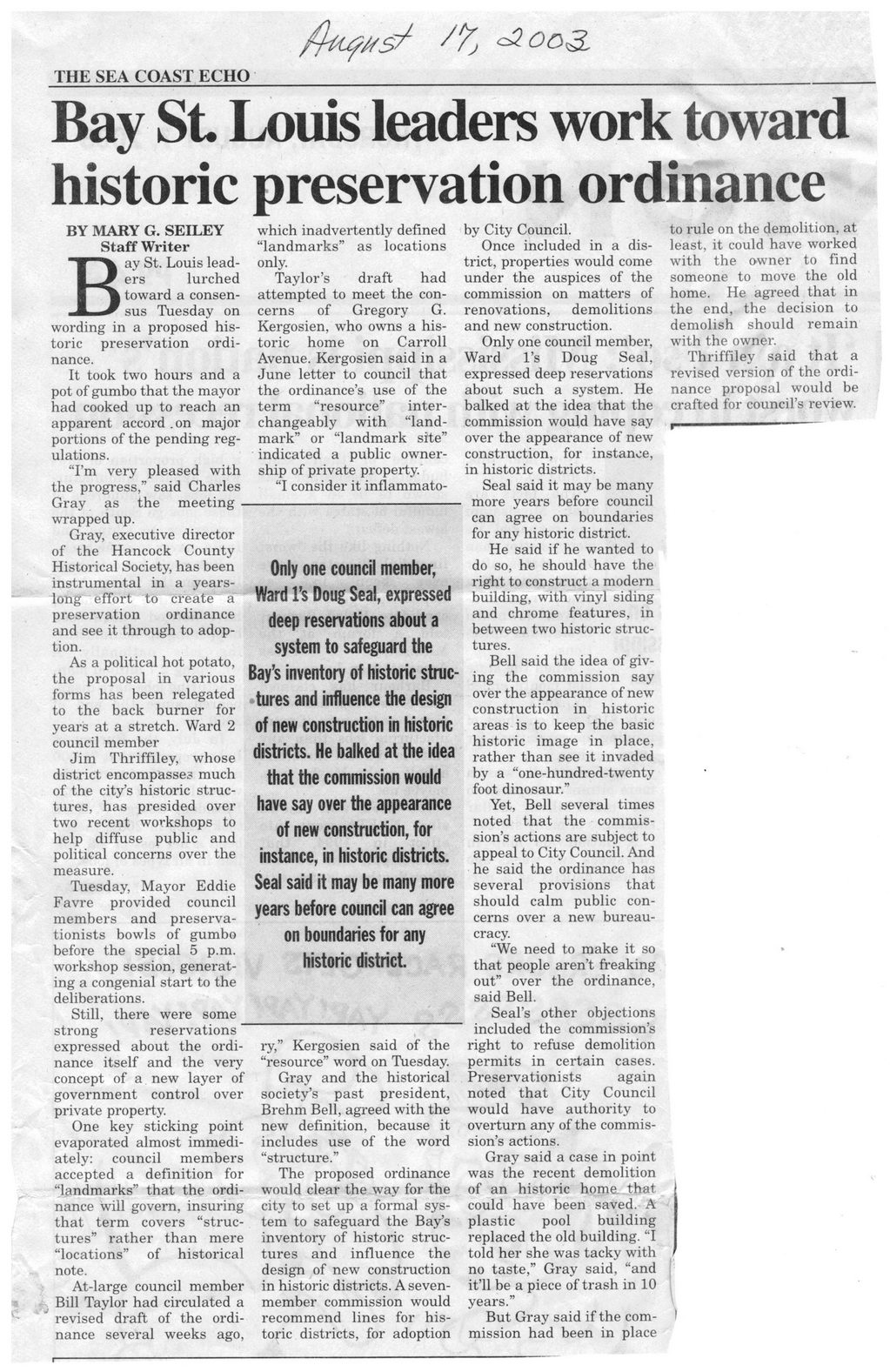This text was obtained via automated optical character recognition.
It has not been edited and may therefore contain several errors.
<^003- THE SEA COAST ECHO Bay St Louis leaders work toward historic preservation ordinance BY MARY G. SEILEY Staff Writer Bay St. Louis leaders lurched toward a consensus Tuesday on wording in a proposed historic preservation ordinance. It took two hours and a pot of gumbo that the mayor had cooked up to reach an apparent accord .on major portions of the pending regulations. “I’m very pleased with the progress,” said Charles Gray as the meeting -wrapped up. Gray, executive director of the Hancock County Historical Society, has been instrumental in a years-long effort to create a preservation ordinance and see it through to adoption. As a political hot potato, the proposal in various forms has been relegated to the back burner for years at a stretch. Ward 2 council member Jim Thriffiley, whose district encompasses much of the city’s historic structures, has presided over two recent workshops to help diffuse public and political concerns over the measure. Tuesday, Mayor Eddie Favre provided council members and preservationists bowls of gumbo before the special 5 p.m. workshop session, generating a congenial start to the deliberations. Still, there were some strong reservations “ expressed about the ordinance itself and the very concept of a new layer of government control over private property. One key sticking point evaporated almost immediately: council members accepted a definition for “landmarks” that the ordinance will govern, insuring that term covers “structures” rather than mere “locations” of historical note. At-large council member Bill Taylor had circulated a revised draft of the ordinance several weeks ago, which inadvertently defined “landmarks” as locations only. Taylor’s draft had attempted to meet the concerns of Gregory G. Kergosien, who owns a historic home on Carroll Avenue. Kergosien said in a June letter to council that the ordinance’s use of the term “resource” interchangeably with “landmark” or “landmark site” indicated a public ownership of private property. “I consider it inflammato- Only one council member, Ward l’s Doug Seal, expressed deep reservations about a system to safeguard the Bay’s inventory of historic structures and influence the design of new construction in historic districts. He balked at the idea that the commission would have say over the appearance of new construction, for instance, in historic districts. Seal said it may be many more years before council can agree on boundaries for any historic district. ry,” Kergosien said of the “resource” word on Tuesday. Gray and the historical society’s past president, Brehm Bell, agreed with the new definition, because it includes use of the word “structure.” The proposed ordinance would clear the way for the city to set up a formal system to safeguard the Bay’s inventory of historic structures and influence the design of new construction in historic districts. A seven-member commission would recommend lines for historic districts, for adoption by City Council. Once included in a district, properties would come under the auspices of the commission on matters of renovations, demolitions and new construction. Only one council member, Ward l’s Doug Seal, expressed deep reservations about such a system. He balked at the idea that the commission would have say over the appearance of new construction, for instance, in historic districts. Seal said it may be many ■ more years before council can agree on boundaries for any historic district. He said if he wanted to do so, he should have the right to construct a modern building, with vinyl siding and chrome features, in between two historic structures. Bell said the idea of giving the commission say over the appearance of new construction in historic areas is to keep the basic historic image in place, rather than see it invaded by a “one-hundred-twenty foot dinosaur.” Yet, Bell several times noted that the commission’s actions are subject to appeal to City Council. And he said the ordinance has several provisions that should calm public concerns over a new bureaucracy. “We need to make it so that people aren’t freaking out” over the ordinance, said Bell. Seal’s other objections included the commission’s right to refuse demolition permits in certain cases. Preservationists again noted that City Council would have authority to overturn any of the commission’s actions. Gray said a case in point was the recent demolition of an historic home, that could have been saved. A plastic pool building replaced the old building. “I told her she was tacky with no taste,” Gray said, “and it’ll be a piece of trash in 10 years.” But Gray said if the commission had been in place to rule on the demolition, at least, it could have worked with the owner to find someone to move the old home. He agreed that in the end, the decision to demolish should remain with the owner. Thriffiley said that a revised version of the ordinance proposal would be crafted for council’s review. P

Ordinances Document (03)